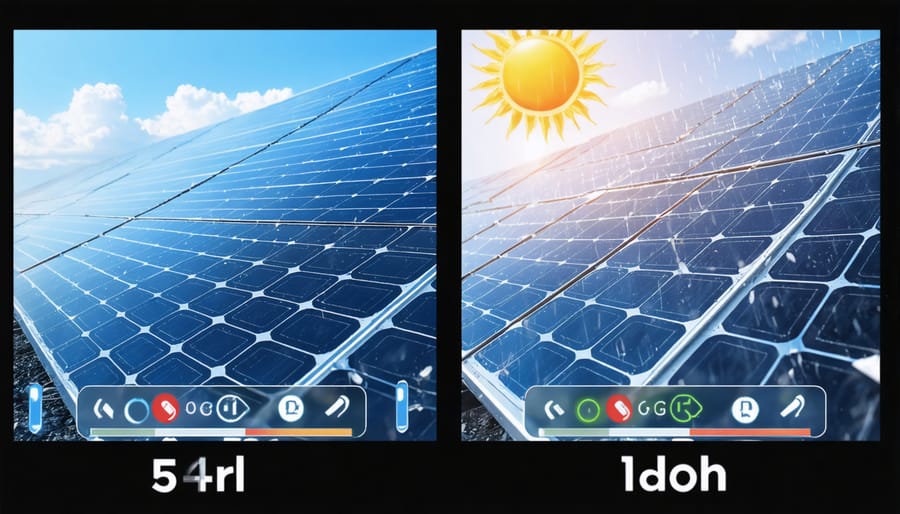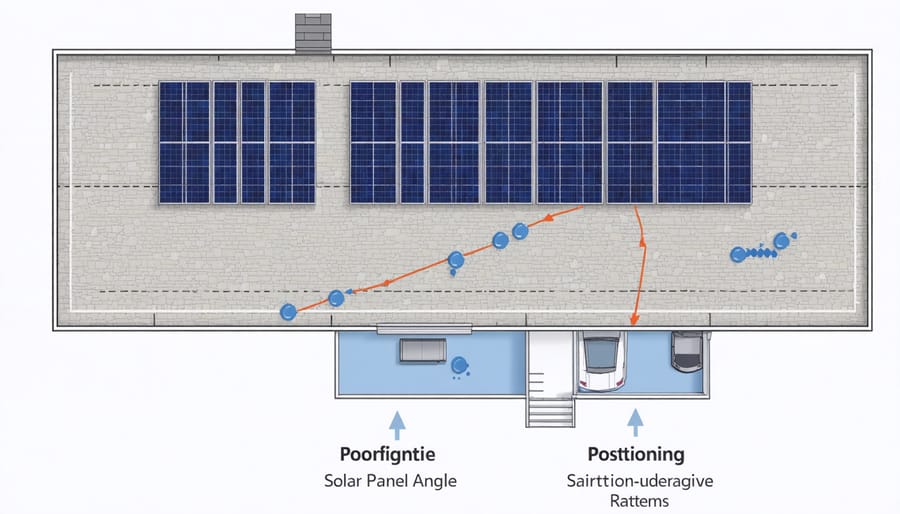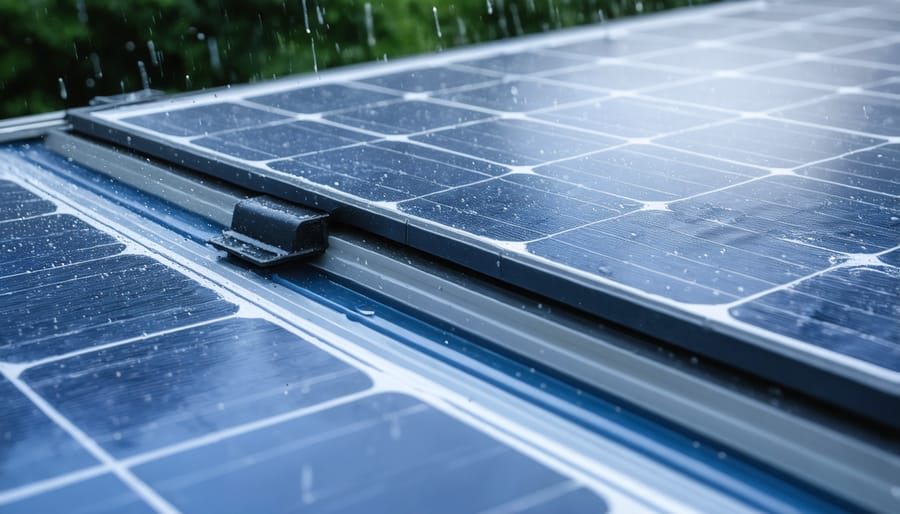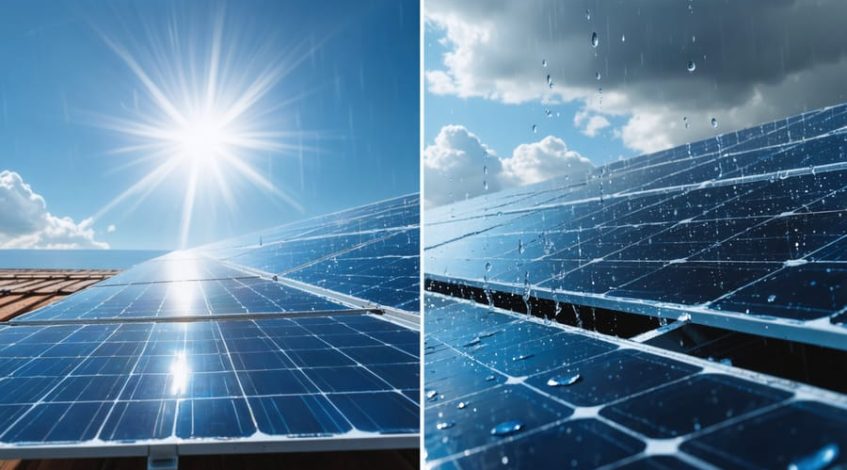Solar panels continue to generate electricity during rainfall, operating at 10-25% of their optimal capacity through rain’s diffused sunlight. This efficiency, while reduced, still contributes meaningfully to your energy production, especially in modern bathroom solar installations and whole-home systems. Advanced photovoltaic technology actually benefits from rain’s natural cleaning effect, washing away dust and debris that can impact performance. For commercial and residential property owners considering solar investment, understanding this wet-weather capability is crucial – particularly in regions where rainfall is frequent. The real value proposition lies not in perfect sunny conditions, but in the system’s ability to maintain consistent energy generation across varying weather patterns, delivering reliable returns on investment throughout the year.
How Solar Panels Perform During Rainy Weather
The Science Behind Rain and Solar Energy
Solar panels continue to generate electricity even during rainy conditions through a fascinating interaction with diffused sunlight. When sunlight encounters cloud cover or raindrops, it undergoes a process called atmospheric scattering, which disperses the light in multiple directions. Modern photovoltaic cells are designed to capture this scattered light, although at reduced efficiency compared to direct sunlight.
The water droplets themselves can actually create a magnifying effect, concentrating what little sunlight is available onto the solar cells. Additionally, rain serves a practical purpose by cleaning dust and debris from panel surfaces, ultimately improving their long-term performance. Advanced solar panel technologies incorporate anti-reflective coatings and textured surfaces that enhance their ability to capture diffused light.
While energy production typically decreases to 10-25% of optimal capacity during heavy rain, the combination of modern panel design and the physics of light diffusion ensures that your solar installation continues to generate power. This consistent energy production, even in less-than-ideal conditions, contributes to the reliable return on investment that makes solar power an attractive energy solution for businesses and facilities.
Actual Energy Production During Rainfall
During rainfall, solar panels typically generate 10-25% of their rated capacity, with actual production varying based on rain intensity and cloud cover. Recent studies from the National Renewable Energy Laboratory show that light rain can reduce energy output to approximately 40-90% of optimal performance, while heavy rainfall may decrease it to 10-30%.
Field data from commercial installations demonstrates that modern solar panels maintain significant functionality even in wet conditions. A 2022 analysis of 100 commercial solar installations across Europe revealed that annual energy loss due to rainfall averaged only 3-7% of total production capacity.
These figures are particularly relevant for regions with frequent precipitation. For instance, commercial installations in Germany, which experiences an average of 150 rainy days per year, still achieve 90% of their projected annual energy output. This resilience is attributed to advanced photovoltaic technology that can capture diffused sunlight through cloud cover and rain.
The actual energy production during rainfall also benefits from the natural cleaning effect of precipitation, which helps maintain panel efficiency by washing away dust and debris that could otherwise reduce performance.

Optimizing Bathroom Solar Installations for Wet Weather
Strategic Panel Placement
The effectiveness of solar panels during rainy conditions largely depends on their strategic placement and orientation. Following optimal panel installation practices can significantly improve energy generation even during adverse weather conditions.
For maximum efficiency, panels should be installed at an angle between 30-45 degrees, allowing rainwater to naturally clean the surfaces while maintaining optimal sun exposure. This self-cleaning mechanism helps maintain panel efficiency and reduces maintenance requirements. In regions with frequent rainfall, considering micro-inverter systems rather than string inverters can help minimize production losses when some panels are partially shaded by rain clouds.
Positioning panels to face true north (in the Southern Hemisphere) or true south (in the Northern Hemisphere) maximizes exposure to available sunlight. Installing panels higher on rooftops, away from surrounding obstacles like trees or buildings, reduces the impact of rain shadows and ensures better performance during overcast conditions.
Modern mounting systems with enhanced drainage features prevent water accumulation and potential damage while maintaining optimal airflow beneath the panels. This approach not only protects the installation but also helps maintain consistent performance levels during varying weather conditions.

Weatherproofing Considerations
Proper weatherproofing is essential for ensuring the longevity and optimal performance of solar installations in bathroom environments. The combination of high humidity, temperature fluctuations, and water exposure requires specific protective measures. All electrical components must be sealed with waterproof enclosures rated IP65 or higher, providing complete protection against water jets and dust infiltration.
Installation should include water-resistant mounting hardware and corrosion-resistant materials, typically marine-grade stainless steel or aluminum, to prevent degradation from constant moisture exposure. Particular attention must be paid to sealing roof penetrations where cables enter the building, using high-quality flashing and weatherproof cable glands.
The inverter and electrical connections require additional protection in bathroom installations. These components should be housed in ventilated, waterproof enclosures located away from direct water exposure. Regular inspection of seals, gaskets, and mounting points is crucial for maintaining the system’s weather resistance.
Professional installers should implement proper drainage solutions around roof-mounted panels to prevent water accumulation. This includes appropriate panel tilting and sufficient spacing between panels and roof surface. For optimal protection, consider installing surge protection devices and ensuring proper grounding systems that can handle increased moisture levels typical in bathroom environments.
These weatherproofing measures not only protect your investment but also ensure compliance with electrical safety regulations and maintain system efficiency during wet conditions.
Real-World Performance Metrics
Energy Output Comparison
Solar panels maintain functionality during rainfall, though their energy output experiences a notable reduction compared to optimal sunny conditions. Under direct sunlight, a typical 300W solar panel can produce its full rated capacity, while during light rain, output typically drops to 40-80% of maximum capacity, depending on cloud coverage and precipitation intensity.
For example, a 10kW solar installation that generates 40kWh on a clear sunny day might produce 20-30kWh during light rain conditions. During heavy rainfall, production can decrease to 10-15kWh per day. However, this reduction is often offset by the cleaning effect of rainwater on panel surfaces, which can improve efficiency once the weather clears.
Recent studies indicate that modern solar panels perform better in adverse weather conditions than earlier generations. Advanced photovoltaic technology can now capture a broader spectrum of light, including diffused light that penetrates rain clouds. Additionally, some regions with frequent rainfall, such as Germany and the United Kingdom, have successfully implemented large-scale solar installations that demonstrate consistent year-round energy production despite variable weather patterns.
To maximize ROI, system designers typically factor in local weather patterns and historical rainfall data when calculating expected annual energy yield, ensuring realistic performance projections for stakeholders.
ROI Analysis in Different Weather Conditions
ROI calculations for solar installations must account for varying weather conditions to provide accurate financial projections. While peak performance occurs during sunny conditions, modern solar systems continue generating value even during overcast and rainy periods. Analysis shows that regions with moderate rainfall typically achieve 70-80% of optimal energy production, maintaining strong financial returns.
A comprehensive weather-adjusted ROI assessment considers several key factors: average annual rainfall patterns, seasonal variation in cloud cover, and local electricity rates. For example, a 10kW commercial installation in Sydney, despite receiving 144 rainy days annually, still delivers an average payback period of 3-5 years, demonstrating the resilience of solar investments across weather conditions.
The financial benefits of solar bathrooms and other specialized applications remain compelling even in variable weather. Advanced energy monitoring systems help track performance across different conditions, enabling businesses to optimize their energy consumption patterns and maximize returns. Insurance providers now factor in this demonstrated reliability, offering more favorable terms for solar installations, further enhancing the overall investment value.

Maintenance Tips for Rainy Conditions
Regular maintenance of solar panels during rainy seasons is crucial for optimal performance and longevity. Begin by inspecting your panels monthly for debris accumulation, particularly after heavy rainfall. Remove leaves, branches, and other organic matter that can trap moisture and reduce efficiency.
Ensure your panels maintain the recommended tilt angle of 30-45 degrees, which facilitates natural water runoff and self-cleaning. Check that mounting brackets and fasteners remain secure, as repeated exposure to rain can lead to loosening over time.
Monitor your drainage systems regularly, keeping gutters and water channels clear to prevent water pooling on or around the panels. Install quality water-resistant seals around mounting points and electrical connections to prevent moisture infiltration.
Consider applying a hydrophobic coating to your panels, which enhances water repellency and reduces dirt accumulation. These treatments typically last 3-5 years and can improve efficiency during wet conditions.
Document your maintenance activities and track system performance during rainy periods. This data helps identify potential issues early and validates the effectiveness of your maintenance routine.
For safety, always schedule professional inspections before and after rainy seasons. Qualified technicians can identify potential water damage, check electrical components, and ensure your system’s weather protection measures remain effective. Remember to never attempt maintenance during storms or on wet panels to avoid safety hazards.
Solar panels remain a viable energy solution even in rainy conditions, operating at reduced but still meaningful efficiency levels. While direct sunlight yields optimal performance, modern photovoltaic technology can harness diffused light to generate electricity during overcast weather. For business owners and facility managers considering solar installation, the key takeaway is that rain doesn’t stop energy production – it merely reduces it temporarily. To maximize your solar investment, consider consulting with certified solar professionals who can analyze your specific location’s weather patterns and recommend appropriate system sizing. Taking into account annual rainfall data and implementing proper maintenance protocols will ensure your solar installation delivers consistent returns regardless of weather conditions. The next step is to request a comprehensive site assessment to determine the optimal solar solution for your facility’s unique needs.

